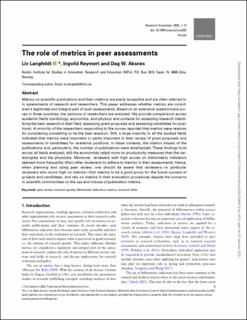| dc.contributor.author | Langfeldt, Liv | |
| dc.contributor.author | Reymert, Ingvild S | |
| dc.contributor.author | Aksnes, Dag W. | |
| dc.date.accessioned | 2021-01-08T12:51:19Z | |
| dc.date.available | 2021-01-08T12:51:19Z | |
| dc.date.created | 2020-12-28T08:36:43Z | |
| dc.date.issued | 2020 | |
| dc.identifier.citation | Langfeldt, L., Reymert, I. & Aksnes, D. W. (2020). The role of metrics in peer assessments. Research Evaluation, 1-15. | en_US |
| dc.identifier.issn | 0958-2029 | |
| dc.identifier.uri | https://hdl.handle.net/11250/2722202 | |
| dc.description.abstract | Metrics on scientific publications and their citations are easily accessible and are often referred to in assessments of research and researchers. This paper addresses whether metrics are considered a legitimate and integral part of such assessments. Based on an extensive questionnaire survey in three countries, the opinions of researchers are analysed. We provide comparisons across academic fields (cardiology, economics, and physics) and contexts for assessing research (identifying the best research in their field, assessing grant proposals and assessing candidates for positions). A minority of the researchers responding to the survey reported that metrics were reasons for considering something to be the best research. Still, a large majority in all the studied fields indicated that metrics were important or partly important in their review of grant proposals and assessments of candidates for academic positions. In these contexts, the citation impact of the publications and, particularly, the number of publications were emphasized. These findings hold across all fields analysed, still the economists relied more on productivity measures than the cardiologists and the physicists. Moreover, reviewers with high scores on bibliometric indicators seemed more frequently (than other reviewers) to adhere to metrics in their assessments. Hence, when planning and using peer review, one should be aware that reviewers—in particular reviewers who score high on metrics—find metrics to be a good proxy for the future success of projects and candidates, and rely on metrics in their evaluation procedures despite the concerns in scientific communities on the use and misuse of publication metrics. | en_US |
| dc.language.iso | eng | en_US |
| dc.publisher | Oxford University Press | en_US |
| dc.relation.uri | https://doi.org/10.1093/reseval/rvaa032 | |
| dc.rights | Navngivelse-Ikkekommersiell 4.0 Internasjonal | * |
| dc.rights.uri | http://creativecommons.org/licenses/by-nc/4.0/deed.no | * |
| dc.subject | Peer review | en_US |
| dc.subject | Research quality | en_US |
| dc.subject | Bibliometric indicators | en_US |
| dc.subject | Metrics | en_US |
| dc.subject | Research fields | en_US |
| dc.title | The role of metrics in peer assessments | en_US |
| dc.type | Peer reviewed | en_US |
| dc.type | Journal article | en_US |
| dc.description.version | publishedVersion | en_US |
| dc.source.journal | Research Evaluation | en_US |
| dc.identifier.doi | https://doi.org/10.1093/reseval/rvaa032 | |
| dc.identifier.cristin | 1863449 | |
| dc.relation.project | Norges forskningsråd: 256223 | en_US |
| cristin.ispublished | true | |
| cristin.fulltext | original | |
| cristin.qualitycode | 1 | |

